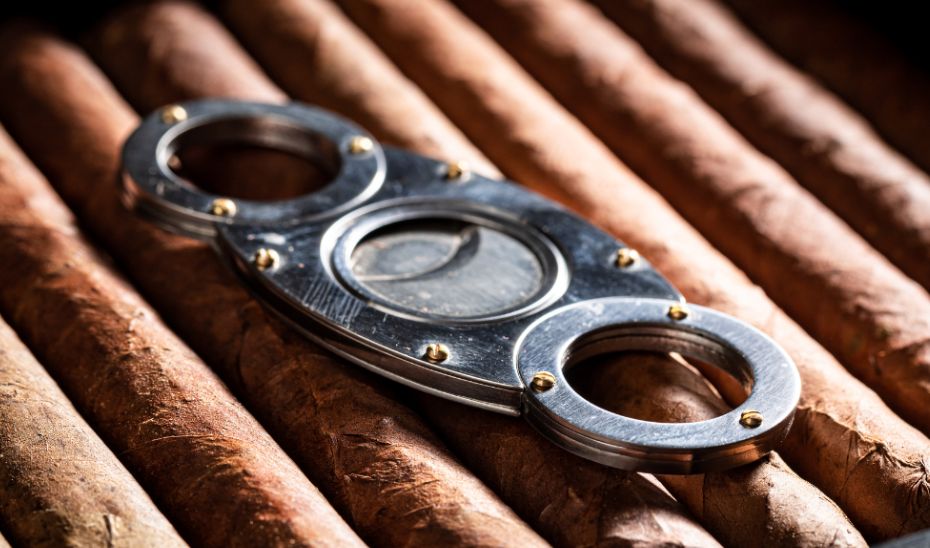Choosing The Right Cutter for cigar
When it comes to enjoying a fine cigar, choosing the right cutter is essential to ensuring a smooth and satisfying smoking experience. There are several different types of cutters available, each with its own unique features and benefits. The most common types of cutters include guillotine cutters, punch cutters, and v-cutters.
Guillotine cutters are perhaps the most popular choice among cigar enthusiasts. This type of cutter features a straight blade that is used to make a clean cut across the cap of the cigar. Guillotine cutters come in both single and double blade varieties, with double blade cutters often providing a cleaner and more precise cut.

Punch cutters are another popular option for cigar smokers. These cutters feature a circular blade that is used to create a small hole in the cap of the cigar. Punch cutters are ideal for those who prefer a more concentrated draw, as they tend to create a smaller opening than guillotine cutters.
V-cutters are a less common but equally effective option for cutting cigars. These cutters feature a v-shaped blade that is used to make a wedge-shaped cut in the cap of the cigar. V-cutters are popular among those who prefer a deeper draw, as they create a wider opening than guillotine or punch cutters.
Ultimately, the right cutter for you will depend on your personal preferences and smoking habits. Whether you prefer a straight cut, a punch cut, or a v-cut, choosing the right cutter is key to enjoying a perfect smoking experience every time.
Where to Cut a cigar?
When it comes to enjoying a cigar, one of the most important steps is knowing where to cut it. The cut of a cigar can significantly affect the smoking experience, as it determines the draw and overall flavor profile. There are several different cutting methods to choose from, each with its own pros and cons.
One of the most common ways to cut a cigar is with a guillotine cutter. This type of cutter provides a clean and precise cut, allowing for a smooth draw and even burn. It is important to make sure that the cutter is sharp and that you cut the cigar just above the cap, where the cap meets the body of the cigar. This will prevent the wrapper from unraveling and ensure a good smoke.
Another popular cutting method is the punch cut, which involves using a small circular blade to create a hole in the cap of the cigar. This method is ideal for those who prefer a tighter draw and want to avoid loose tobacco in their mouth. However, it may not be suitable for larger ring gauge cigars.
Ultimately, the best cutting method will depend on personal preference and the type of cigar being smoked. Experimenting with different cutting techniques can help you find the perfect cut for your smoking experience. Remember, the goal is to enhance the enjoyment of the cigar, so take your time and choose the method that works best for you.
Cigar Moistening
Cigar moistening is a process that involves adding moisture to cigars in order to maintain their freshness and prevent them from drying out. This is particularly important for long-term storage or shipping of cigars, as dry cigars can become brittle and lose their flavor. There are several methods for moistening cigars, including using a humidification device such as a humidor or a cigar jar, or simply placing a damp cloth or sponge near the cigars for a short period of time.
One of the most common ways to moisten cigars is to use a humidor, which is a specially designed box or room that is used to store cigars at a constant humidity level. Humidors typically contain a humidification device, such as a sponge or a humidifier, that helps to regulate the moisture level inside the box. By keeping cigars in a humidor, they can be kept at the optimal humidity level of around 70-72%, which helps to preserve their flavor and prevent them from drying out.

Another method for moistening cigars is to use a cigar jar, which is a small container that is designed to hold a few cigars at a time. Cigar jars often come with a built-in humidification device, such as a sponge or a humidifier, that helps to keep the cigars moist. By storing cigars in a cigar jar, they can be easily transported and kept fresh while on the go.
In conclusion, cigar moistening is an important process for maintaining the freshness and flavor of cigars. Whether using a humidor, a cigar jar, or another method, it is essential to keep cigars at the proper humidity level in order to enjoy them to their fullest.
How To Cut A Cigar With A Knife and Other tools
Cutting a cigar properly is essential to ensure a smooth smoking experience. While there are various tools available for cutting a cigar, using a knife can be a convenient option for many smokers. To cut a cigar with a knife, start by selecting a sharp blade with a straight edge. Hold the cigar firmly in one hand and place the blade of the knife against the cap of the cigar, which is the closed end. Slowly and carefully make a straight cut into the cap, ensuring that you do not cut too deep into the cigar. It is important to make a clean and precise cut to prevent the wrapper from unraveling during smoking.
In addition to using a knife, cigar enthusiasts may also choose to use other tools such as a guillotine cutter or a punch cutter. A guillotine cutter features two blades that come together to make a clean cut, while a punch cutter creates a small hole in the cap of the cigar. Both tools are effective in cutting a cigar, but it ultimately comes down to personal preference.
Regardless of the tool you choose, it is important to remember that the cut should be made at a slight angle to allow for an even draw. Experiment with different cutting methods and tools to find the one that works best for you. With practice and patience, you will be able to master the art of cutting a cigar and enjoy a flavorful smoking experience every time.


